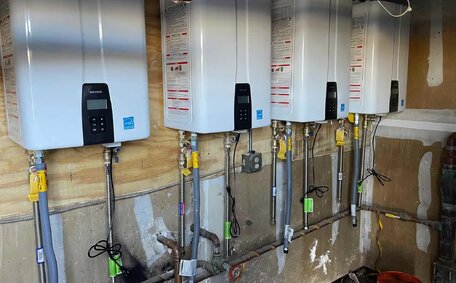What Causes Pipes to Bow or Become Misaligned
Pipes beneath properties bow or misalign for various reasons:
- Ground movement - Shifting soil due to droughts, floods or construction can cause pipes to bend or move out of position.
- Tree roots - As roots spread underground seeking moisture, they can entangle and damage pipes, potentially requiring digging up old pipes for repair or replacement.
- Heavy traffic loads - The weight of heavy vehicles travelling over pipes may cause them to deform over many years.
Misalignments can spread through interconnected pipe networks, affecting the entire system. If one section of pipe becomes distorted, it can throw off pipes connected further downstream.
How Pipe Relining Works
Pipe relining rejuvenates damaged pipes without resorting to excavation. Here are the key steps:
- First, our technicians use a drain camera to thoroughly inspect the pipe and assess if it is suitable for relining.
- We then use specialised equipment to clean and prepare the interior pipe surface.
- A watertight tubular liner soaked in epoxy resin is inserted into the pipe. Liners can be felt or woven fibreglass material.
- The liner expands to adhere tightly to the pipe wall. The resin then cures to form a smooth, new interior pipe surface.
- At junctions, during the relining process, resin is used to seal and reinforce connections between pipe sections.
- Once cured, the new strong liner restores flow capacity and remedies leaking pipes. Relined pipes can last over 50 years with correct installation.
Before relining, we also check the pipe’s structural stability. Any severely damaged sections may still need replacement.
The Effectiveness of Pipe Relining for Bowed or Misaligned Pipes
Properly conducted pipe relining effectively repairs bowed or misaligned pipes, restoring drainage.
Common residential sewer pipes, such as PVC, clay, and concrete, are typically suitable for relining.
We assess the suitability of relining using a drain camera to examine the extent of pipe deformation. However, pipes that are excessively twisted may necessitate replacement.
For pipes with minor to moderate bowing or misalignment issues, epoxy resin liners can provide a custom fit by conforming tightly to the existing pipe walls before curing. This method effectively encases a deformed pipe within a new, straight liner.
We confirm the integrity of your pipe using a post-installation camera inspection. After relining, photos and flow tests typically demonstrate significant improvements. Correctly installed, these liners provide a durable and long-lasting pipe solution.
When Pipe Relining May Not Work
While sewer pipe relining is efficient, it does have several limitations:
- Severely misaligned or bowed pipes that are too deteriorated require replacement. If a pipe is flattened, twisted, or sagging, it likely requires full replacement.
- It can be challenging to reinforce large sections of damaged pipe that need to be excavated. Extensive damaged sections spanning more than 3-4 metres may still require excavation.
- Poor structural integrity means the existing pipe can’t properly support a new liner. Areas with extensive cracks or fractures are problematic.
- Restricted access points prevent liner installation. Technicians need entry points to feed the flexible liner into pipes.
- Persistent inadequate water flow after relining suggests more significant, underlying issues.
Camera inspections guide us in determining when lining may not be the ideal solution, thereby maintaining high-quality service. We would advise our trenchless pipe relining services or traditional methods of pipe replacement instead.
Although relining offers benefits, it’s not a one-size-fits-all solution for every problem. We assess each situation to recommend the most suitable solution.
Considering Alternative Trenchless Repair Methods
Beyond pipe relining, we offer a wide range of trenchless repair techniques that can address issues like bowed or misaligned pipes:
Pipe Bursting
Pipe bursting replaces old pipes by fracturing them and installing new ones of equivalent or greater diameter. A cone-shaped bursting head is fed through the sections pipe, fracturing them outwards. An expander head then pulls the new replacement pipe into place.
Pipe bursting is a method to completely replace severely damaged pipes. It is more suitable than relining for continuous pipe spans longer than 4 metres or pipes needing realignment. This method does require excavation to create entry and exit pits.
Pipe Patch Lining
Pipe patch lining employs custom liners to repair specific pipe damage sections. After identifying problem areas with camera inspection, patches are fashioned to cover the specific sections. The liners only extend 1-2 metres within overall pipe runs.
For relining in Brisbane, patch liners offer a localised repair without the need for full pipe replacement. These patches effectively seal cracks or holes and reinforce vulnerable areas. Patch liners are less costly than relining full runs of pipe.
In our business we assess the overall pipe condition, location of damaged areas and required excavation to recommend the optimal approach for sewer pipe relining options. For professional pipe relining Brisbane advice, feel free to get in touch about the best solution for your plumbing concerns.
Deciding Whether to Reline or Replace Misaligned Pipes
Homeowners must choose between relining or replacing misaligned pipes beneath their property. Careful consideration of the advantages and disadvantages of each option is necessary.
Benefits of Pipe Relining
- Less invasive - Relining eliminates the need for trench-digging on your property.
- Cost-effective - Relining is often preferred, being 30-50% less expensive than pipe replacement.
- Faster repairs - Relining is usually completed in 1-2 days, in contrast to the 1-2 weeks often required for full pipe replacement.
- Landscape preservation - Relining, requiring minimal excavation, avoids damaging gardens and driveways.
Benefits of Pipe Replacement
- Corrects alignment - Full replacement is necessary to properly realign misaligned drainage systems.
- Long-term solution - While liners can last 50+ years if installed correctly, new pipes often last even longer.
- Upsizing capability - Replacement provides the option to increase pipe sizes and enhance water flow.
- Reduced complications - New pipes are less likely to encounter issues such as cracks or tree root intrusions.
A camera inspection will reveal the extent of the damage to guide your choice between relining and replacement. Pipe relining is typically considered for minor to moderate cases of misalignment. However, severely twisted pipes that hinder water flow require replacement.
For personalised advice, email or call 1300 349 338 to schedule an inspection and receive a quote from our trenchless repair experts at Colyton Plumbing Services.






